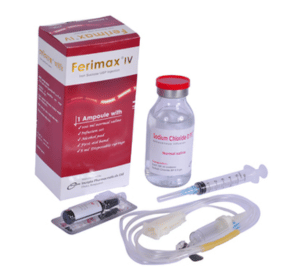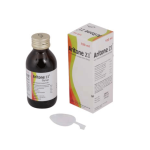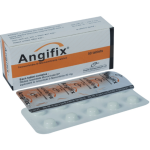Ferimax(Irosn sucrose)

Therapeutic Group: Hematinics
Presentation
Ferimax ® IV: Each 5 ml ampoule contains Iron Sucrose USP 100 mg solution.
Description
Intravenous Iron Sucrose is more effective and well tolerated in comparison with oral Iron preparations and it is the treatment of choice for anemia due to Iron deficiency. Administration of Iron Sucrose replenishes tissue Iron stores, reverses Iron depletion and Iron-deficient erythropoiesis and corrects or prevents Iron deficiency anemia.
Indications
Iron Sucrose is indicated for the treatment of Iron deficiency in the following indications:
Where there is a clinical need for rapid Iron supplyIn patients who cannot tolerate oral Iron therapy or who are non-compliant. In active inflammatory bowel disease where oral preparations are ineffective. Treatment of Iron deficiency anemia in pregnancy and in non-dialysis dependent chronic kidney disease (CKD) patients either receiving or not receiving an erythropoietin, hemodialysis dependent CKD patients receiving an erythropoietin or peritoneal dialysis CKD patients receiving an erythropoietin.
Dosage & Administration
Adults and the Elderly: Iron Sucrose has exclusively to be administered intravenously by slow injection or by drip infusion or directly into the venous limb of the dialyzer. Iron Sucrose must not be used for intramuscular injection.
As injection: Iron Sucrose can also be administered undiluted by slow IV injection at a rate of 1 ml Iron Sucrose (20 mg Iron) in at least 1 minute a maximum of 10 ml Iron Sucrose (200 mg Iron) can be administered per injection in at least 10 minutes.
As infusion: Iron Sucrose should preferably be administered by drip infusion ( in order to reduce hypotensive episodes) in a dilution of 1 ml Iron Sucrose in maximum 20 ml 0.9% NaCl etc up to 25 ml Iron Sucrose in maximum 500 ml 0.9% NaCl. Dilution must take place immediately prior to infusion and solution must be administered as follows: 100 mg Iron in at least 15 minutes; 200 mg Iron in at least 30 minutes ete. Normal posology is to use 5-10 ml Iron Sucrose 1-3 times a week depending on the Hemoglobin level. For the administration of the maximum tolerable dose of 7 mg Iron/kg body weight an infusion time of at least 3.5 hours has to be respected, independently of the total dose.
Children: There is limited data on children under study conditions. If there is a clinical need, it is recommended not to exceed 0.15 ml Iron Sucrose (3 mg Iron) per kg body weight 1-3 times a week depending on the hemoglobin level.
Side-effects
Iron Sucrose is generally well tolerated. However, occasionally metallic taste, headache, nausea, vomiting and hypotension may occur. Less frequently side-effects are paresthesia, abdominal disorders, muscular pain, fever, urticaria, flushing, edema of the extremities, anaphylactic (pseudoallergic) reactions and in the region of the punctured vein, phlebitis and venous spasm have been observed.
Side Effects
N/A
Precautions
Iron Sucrose should be administered with caution in patients with asthma, eczema, other atopic allergies or allergic reaction to other parenteral Iron preparations, low binding capacity and/or folic acid deficiency, liver dysfunction, acute or chronic infection.
Baseline tests: Ensure Hgb, Hct, serum ferritin and transferrin saturation is determined before starting therapy and periodically during treatment. Note that serum Iron levels may be reliably obtained 48 hours after IV dosing.
Blood Pressure: Monitor Blood Pressure during infusion. If hypotension occurs, slow the rate of infusion. If hypotension continues, discontinue infusion and be prepared to treat appropriately.
Discontinue oral Iron preparations before administering parenteral Iron products. Co-administration of parenteral Iron preparations may reduce absorption of oral Iron.The dose will be in terms of elemental Iron. For IV administration only. Not for intradermal, subcutaneous, IM, or intra-arterial administration. Medication is administered 1 to 3 times/ week. Do not administer more than 3 times/week. Discard any unused diluted solution. Do not save unused solution for future use. Do not administer if particulate matter or discoloration noted.
Use in Pregnancy & Lactation
Pregnant women: FDA pregnancy category B.
Lactating mothers: It is not known whether this drug is excreted in human milk. As many drugs are excreted in human milk, caution should be exercised when Iron Sucrose is administered to a nursing woman.
Drug Interaction
Iron Sucrose should not be administered concomitantly with oral Iron preparations since the absorption of oral Iron is decreased. Do not mix with other medication or add to parenteral nutrition solutions for IV infusion.
Over Dose
Iron Sucrose should not be given to people with Iron overload and should be stopped when serum ferritin levels equal or exceed established guidelines. Particular caution should be used to avoid Iron overload where anemia that does not respond to treatment has been incorrectly diagnosed as Iron deficiency anemia. Symptoms associated with overdose or infusing Iron Sucrose too rapidly included hypotension, headache, vomiting, nausea, dizziness, joint aches, paresthesia (abnormal sensation, such as tingling or burning), abdominal and muscle pain, edema and cardiovascular collapse. Most symptoms have been successfully treated with IV fluids, hydrocortisone and/or antihistamines. Infusing the solution as recommended or at a slower rate also may alleviate symptoms.
Storage
Store below 25 °C. Do not freeze. Use immediately after dilution in saline.
Commercial Pack
Ferimax IV: Each box contains 1 amber ampoule of 5 ml Iron Sucrose injection with 100 ml normal saline, an infusion set, alcohol pad, first aid band and a 5 ml disposable syringe.



